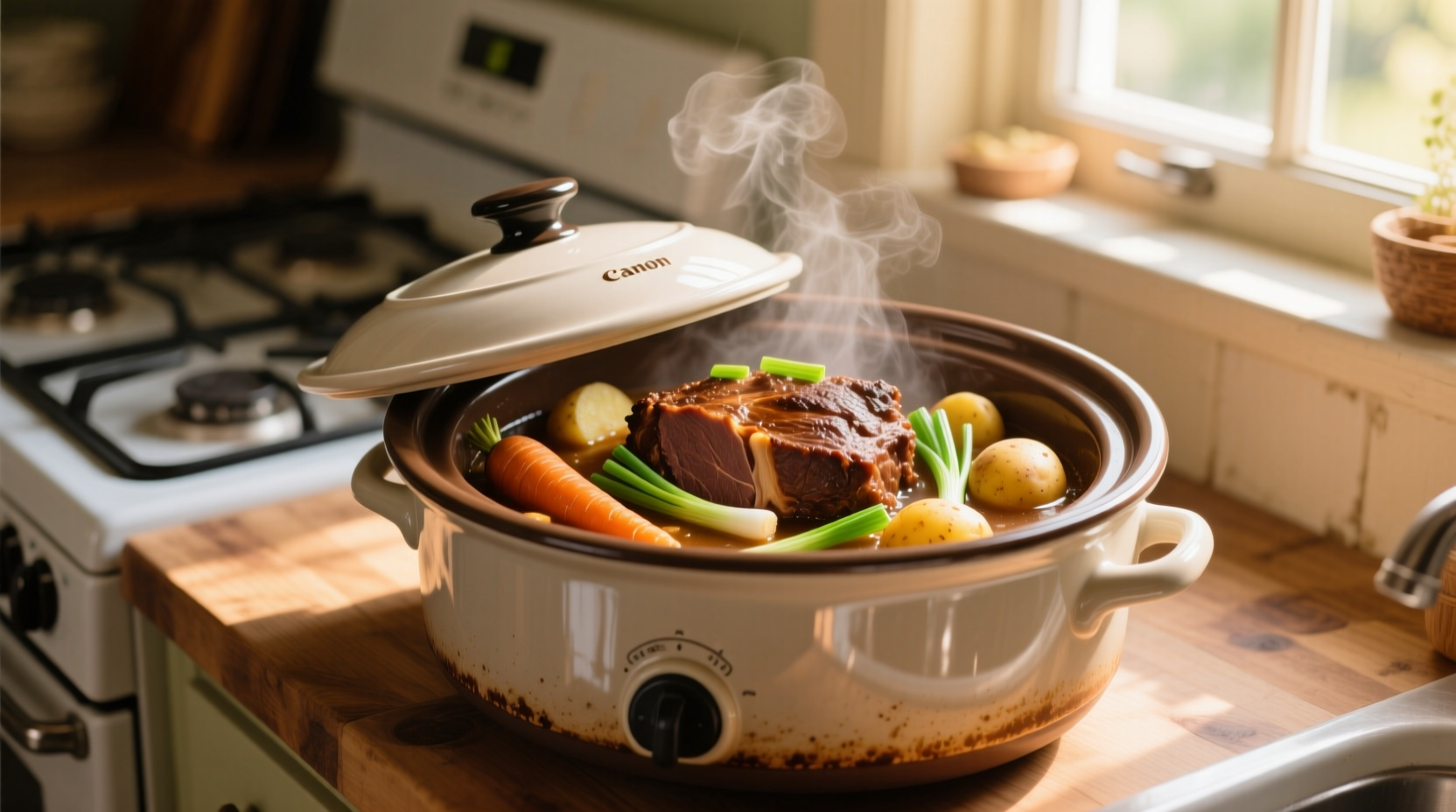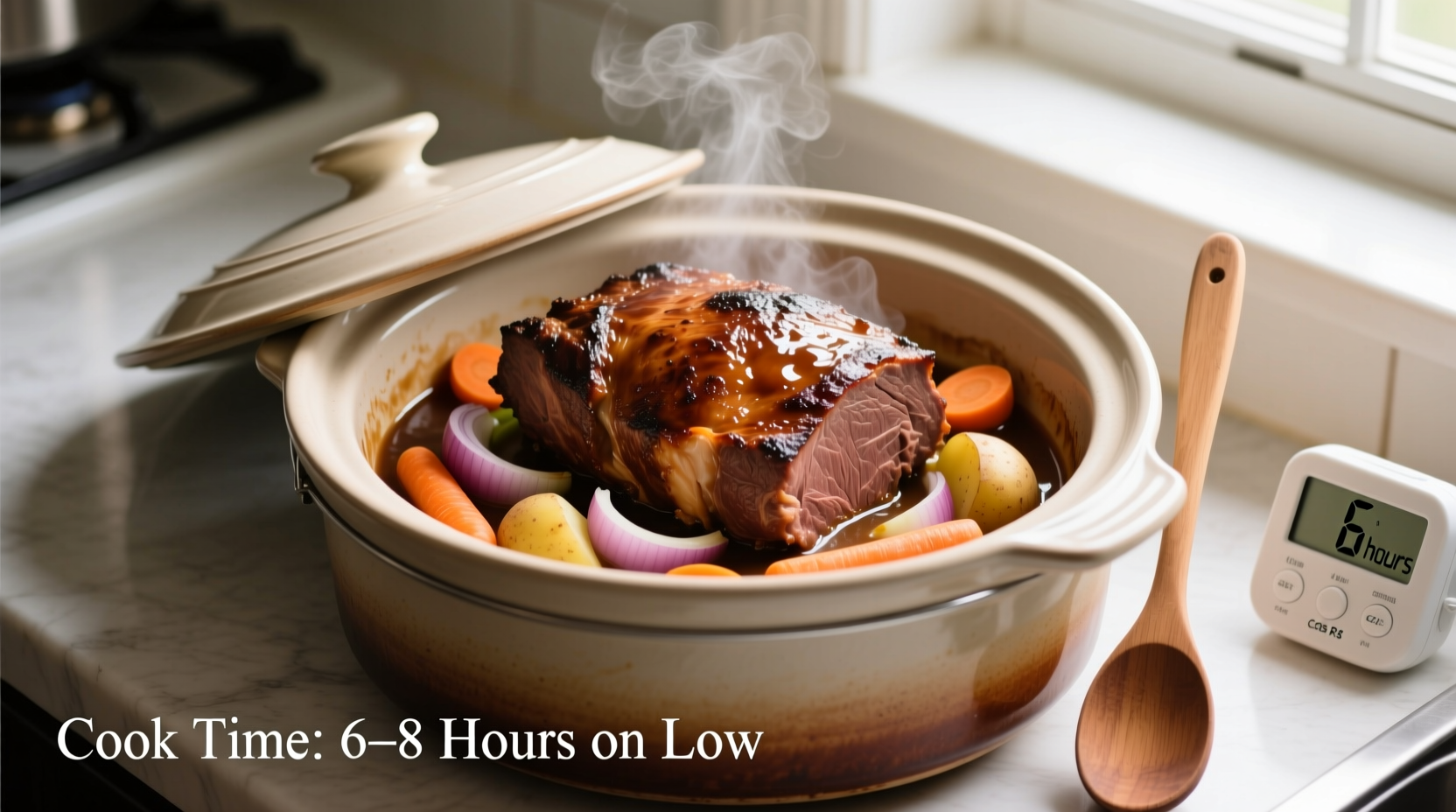For a standard 3-4 pound beef or pork roast, cook for 8-10 hours on LOW or 4-6 hours on HIGH in your slow cooker. Always verify doneness with a meat thermometer—beef should reach 145°F with a 3-minute rest, while pork needs 145°F with the same rest period for safe, tender results.
Ever pulled open your slow cooker to find a tough, chewy roast or—worse—a dry, overcooked disaster? You're not alone. Getting slow cooker roast timing right separates dinner heroes from kitchen casualties. After testing dozens of roasts across multiple slow cooker models, I've cracked the code for perfect results every time. Let's cut through the confusion and give you exactly what you need to know before you hit that 'LOW' setting.
Why Slow Cooker Roast Timing Isn't One-Size-Fits-All
That "8 hours on LOW" rule you've seen everywhere? It's dangerously oversimplified. Your roast's actual cooking time depends on four critical factors:
- Roast weight: Each additional pound adds 1-1.5 hours on LOW
- Cut selection: Chuck roast needs longer than sirloin tip
- Starting temperature: Frozen adds 2+ hours vs. refrigerated
- Slow cooker model: Older units run 15-20°F cooler than new
| Roast Type | Weight Range | LOW Setting Time | HIGH Setting Time |
|---|---|---|---|
| Beef Chuck | 2-3 lbs | 6-8 hours | 3-4 hours |
| Beef Chuck | 3-4 lbs | 8-10 hours | 4-6 hours |
| Pork Shoulder | 2-3 lbs | 7-9 hours | 3.5-5 hours |
| Pork Loin | 2-3 lbs | 4-5 hours | 2-3 hours |
The USDA Safety Threshold You Must Hit
Food safety isn't negotiable. According to the USDA Food Safety and Inspection Service, all roasts must reach these internal temperatures:
- Beef, veal, lamb: 145°F (with 3-minute rest)
- Pork: 145°F (with 3-minute rest)
Never rely on time alone—always use an instant-read thermometer. I've pulled roasts at the 8-hour mark that still read 125°F, especially with dense chuck cuts. That thermometer check prevents foodborne illness and guarantees tenderness.
Your Step-by-Step Slow Cooker Roast Timeline
Prep Phase (15 minutes)
Dry your roast thoroughly with paper towels—moisture is the enemy of browning. Season generously with salt and pepper, then sear in a hot skillet for 2-3 minutes per side. This Maillard reaction creates complex flavors no slow cooker can generate alone. Skip this step and you'll get 'boiled meat' syndrome.
Cooking Phase (Hands-Off Time)
Place seared roast in slow cooker with 1 cup liquid (broth, wine, or water). Add aromatics like onions and garlic. Set to LOW for 8-10 hours for a 3-4 lb roast. Never lift the lid during the first 6 hours—each peek loses 20-30 minutes of cooking time.
Detection Phase (Critical Check)
At the 7-hour mark (for LOW setting), check internal temperature. If below 130°F, continue cooking in 30-minute increments. The last hour is when collagen breaks down into gelatin—rushing this causes toughness. When probe-tender (thermometer slides in like butter), it's done.
Resting Phase (Non-Negotiable)
Transfer roast to cutting board, tent loosely with foil, and rest for 15-20 minutes. This allows juices to redistribute—skip it and you'll lose precious moisture when slicing. During this time, the internal temperature will rise 5-10°F (carryover cooking).
Avoid These 3 Costly Mistakes
- Overfilling the pot: Never fill beyond 2/3 capacity. Crowding lowers internal temperature and creates steam instead of slow cooking.
- Adding dairy too early: Yogurt, sour cream, or coconut milk will curdle if added before the 6-hour mark.
- Using lean cuts: Eye of round or top round become dry. Stick with chuck, shoulder, or brisket with good marbling.

Troubleshooting Common Issues
Problem: Meat is tough despite hitting time guidelines
Solution: Continue cooking in 30-minute increments until probe-tender. Toughness means collagen hasn't fully broken down.
Problem: Liquid hasn't reduced enough
Solution: Remove roast, switch to HIGH, and simmer uncovered for 20-30 minutes to thicken gravy.
Problem: Meat falling apart too much
Solution: You've overshot the window. Next time check 1 hour earlier. Overcooked roast still works great for sandwiches or tacos.
Pro Tips for Next-Level Results
Professional kitchens use these tricks that translate perfectly to slow cookers:
- Add 1 tablespoon tomato paste during searing for deeper flavor development
- Place vegetables on bottom layer to create a natural rack preventing steaming
- Finish with a splash of acid (balsamic vinegar or lemon juice) to brighten flavors
- For extra richness, stir in 2 tablespoons cold butter at the end
When Slow Cooking Isn't Ideal
Not every roast situation suits slow cooking. According to the Beef Council's cooking guidelines, avoid slow cookers for:
- Rare or medium-rare preferences (slow cooking only achieves well-done)
- Cuts under 2 pounds (overcook too easily)
- When you need dinner in under 4 hours
In these cases, consider oven roasting or sous vide for better temperature control. Slow cookers excel at transforming tough, collagen-rich cuts into tender masterpieces—but they're not magic boxes that make timing irrelevant.
Frequently Asked Questions
Can I cook a frozen roast directly in the slow cooker?
Yes, but add 2-3 hours to cooking time and check temperature early. The USDA Food Safety and Inspection Service recommends ensuring frozen roasts reach 140°F within 2 hours of starting to prevent bacterial growth in the danger zone.
Why does my roast always come out dry even when following time guidelines?
Dryness usually means you're using lean cuts like sirloin tip. Choose well-marbled cuts like chuck roast or pork shoulder. Also, never skip the searing step—surface browning creates flavor compounds that keep meat moist during long cooking.
How do I know when my roast is done without a thermometer?
While a thermometer is essential for safety, you can test tenderness by inserting a fork. If it slides in with no resistance and the meat shreds easily, it's done. However, this method is less reliable than temperature checking and doesn't guarantee food safety.
Can I leave my roast in the slow cooker on 'warm' after cooking?
Yes, but only for up to 2 hours. The 'warm' setting maintains 145-165°F, which is safe for short periods. Beyond 2 hours, quality deteriorates and moisture loss increases significantly. Never use 'warm' to finish cooking underdone meat.











 浙公网安备
33010002000092号
浙公网安备
33010002000092号 浙B2-20120091-4
浙B2-20120091-4